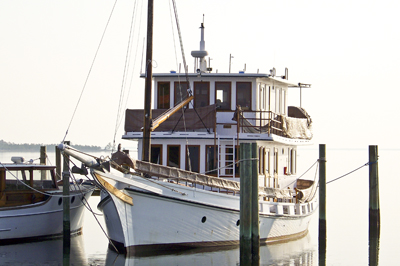A Skipjack is...a Skipjack
The original purpose of the Last Skipjacks Project was to figure out how many skipjacks were left. But before you can count how many remain, you have to decide what you are going to count.
A skipjack is a wooden boat. Except when it's made of fiberglass. A skipjack has a single mast and two sails. Except when it has two masts and three sails. Or no mast or sails at all. A skipjack has a hard-chine hull—a sharp edge separating the side and bottom of the hull, rather than a smooth transition as in most sailboats. Except when it has a rounded, sloop-like hull. A skipjack has a shallow draft and a retractable centerboard instead of a deep fixed keel. Except when it doesn't have a centerboard and does have a keel. A skipjack has an external pushboat as its engine. Except when it has an inboard engine. So far, this isn't very helpful...

For the purposes of this Project, the skipjacks included are all wooden boats that either currently are or once were generally considered as skipjacks. No fiberglass-hull boats are included.
Most look like the traditional Chesapeake Bay oyster dredging vessel, with one raked mast, one huge main sail and one jib. There are a few included that were built as traditional skipjacks and worked as oyster dredgers, but now have been transformed into utterly different looking vessels, like Connie Francis, above, which was found renamed as Oyster Catcher, looking nothing like her skipjack origin.
Some are still working as oyster dredge boats. Some have new life as tourist vessels. Some are being restored. Some are abandoned wrecks, parts of them still visible, but essentially dead boats.
The boats included have been divided into those that originally were built to be dredge boats (whether or not they still serve that purpose), full-size skipjacks that originally were built to be recreational vessels (whether or not they now may work as dredge boats), smaller or "baby" skipjacks under about 30 feet on deck and originally built as pleasure craft, and those boats that have been lost since the Project began.
There are some boats that have the traditional skipjack hull, but their two-mast sail rig had them generally called "three-sail bateaux" rather than skipjacks. While we have not been keeping track of these as we have the traditional skipjacks, it finally became apparent that they should be included as a separate category, as they have been known to change rigs and become acknowledged as skipjacks. We welcome any additions to this list.
Those three-sail bateaux that have been reconfigured to a single-mast skipjack rig and now are called skipjacks by their owners and fit the general description have been included in the appropriate skipjack categories.
